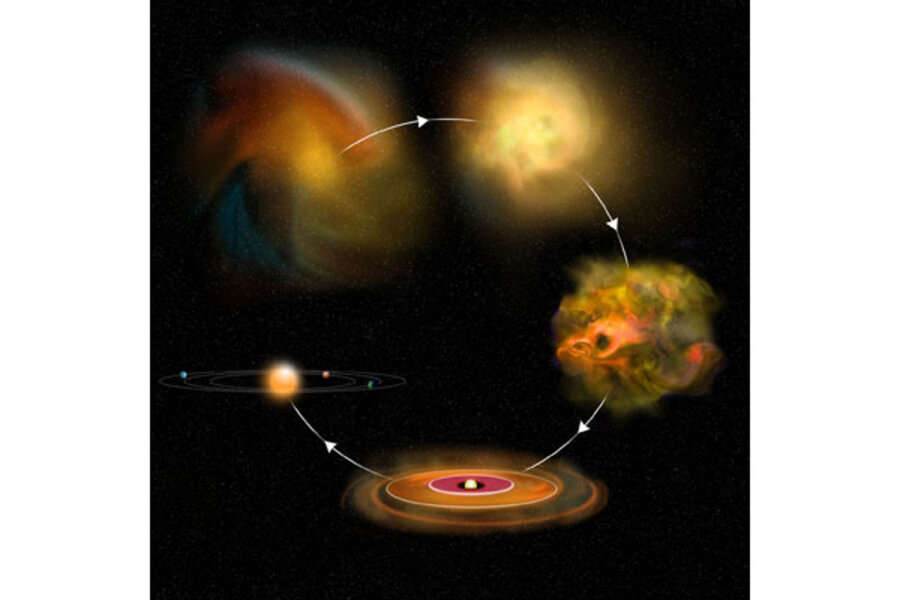How does star-making start? For first time, scientists might get a glimpse.
Loading...
Long before a star is a gleam in anyone's telescope, it begins its ascent to stardom as a cold fragment in a vast cloud of gas and dust.
A team of astronomers reports capturing one of these stellar embryos in a small corner of an enormous molecular cloud some 600 light-years away in the constellation Perseus.
If the team's interpretation of its data holds up to further scrutiny, the region would open a window on a critical, poorly understood stage of a star's evolution.
Much of what astronomers have learned about star formation comes from studying molecular clouds where stars already have formed. These clouds continue to produce relatively dense clumps of dust and gas that will become another generation of stars. But the formation and evolution of these newcomers can be heavily influenced by their already burning siblings.
For example, young stars burn hot and so give off strong stellar winds, which can sweep surrounding regions clean of other gas clumps. When there are clusters of young stars, this process becomes especially powerful. Even a star ending its life in an enormous explosion called a supernova can stifle star formation nearby because of the material the blast ejects. On the other hand, at longer distances, stellar winds or a shock wave from a supernova can trigger clumping.
Pristine stellar nursery
These processes make it difficult to answer the question: What processes influence the first stars to form in a cloud? The segment of the Perseus molecular cloud the team studied hosts no other stars, providing a pristine stellar nursery for testing hypotheses about these initial influences.
“Some stars have to form first for those later triggers to develop,” says James Di Francesco, an astronomer at the University of Victoria in British Columbia and a member of the team reporting the results in an upcoming issue of the journal Astronomy & Astrophysics.
“What's exciting about this discovery is that we see what we think is a clump of gas that's formed within a molecular cloud that is further fragmenting into individual pieces – forming a first generation of cores” available to become stars, he says.
“It's a rare find,” noted Sarah Sadavoy, a graduate student at the University of Victoria and the study's lead author, in a prepared statement.
She and her colleagues note that in 2010 another group reported the discovery of a candidate region for still-gathering fragments – the even denser sections of a gas clump that can eventually become stars – but that team was unable to detect any individual fragments.
The region of the Perseus cloud Ms. Sadavoy and colleagues studied is known as Perseus B1-E. It's one of five prominent regions of gas and dust in the cloud dense enough to act as a large-scale stellar nursery. Two of the other regions host either evolved stars or so-called young stellar objects, which are much farther along on their path from cold clump to cosmic beacon.
Scientists offer explanations for how conditions in a pristine clump of gas can influence the formation of fragments.
Turbulence within the clump can lead to regions with higher densities than others. These regions become the fragments, which begin to collapse under their own gravity, gathering additional gas and dust from their surroundings as they grow. At some point, a fragment becomes so dense that it begins to heat. Eventually temperatures rise to the point where atoms in the core fuse, releasing enormous amounts of energy. The star is born.
But magnetic fields within a molecular cloud could also delay the collapse of a cloud fragment into a stellar core, some researchers hold. Although the cloud is laced with electrically neutral molecules, it also contains electrically-charged particles. These respond to magnetic fields in the cloud. If a fragment is in a region of its parent cloud where magnetic fields are strong, these fields can exert an outward pull to counteract gravity's inward tug on the fragment, Di Francesco explains.
The fact that stars exist, he adds, would testify to a threshold beyond which gravity wins.
While the team has no way to measure magnetic fields in the fragments' host clump, the researchers suggest that such fields may be the reason why B1-E isn't as far along in its star-forming activity as are other regions of the Perseus molecular cloud.
Search for a star-in-waiting
The team used the European Space Agency's Herschel infrared observatory, launched in May 2009, to make its initial observations of B1-E. The broad clump yielded evidence of nine fragments. They tipped the scales at from 0.3 to 1.6 times the mass of the sun and ranged in size from just over 5 AU to 9 AU. One AU, or astronomical unit, is 93 million miles – the average distance at which Earth orbits the sun.
The team then turned to the US National Radio Astronomy Observatory's 100-meter dish telescope at Greenbank, W. Va. to determine the motions of these objects. They used the spectrum of an ammonia molecule as a speedometer. Ammonia is a common component of molecular clouds. In a fragment where ammonia was speeding away at high relatively velocity, gas and dust could be collapsing to form a stellar core, the team suggests.
“Based on the variety of the velocities we could see, there was one location that seemed to be well on its way to forming a core, “ Dr. Di Francesco says. “The others may still be sloshing around in the clump. Some may still grow. Some may disperse.”







